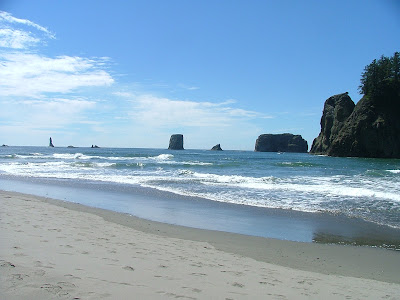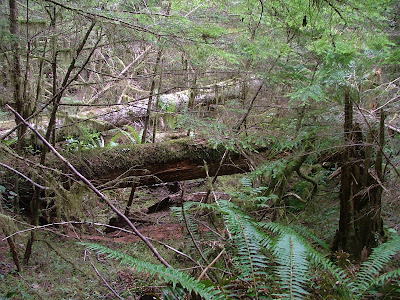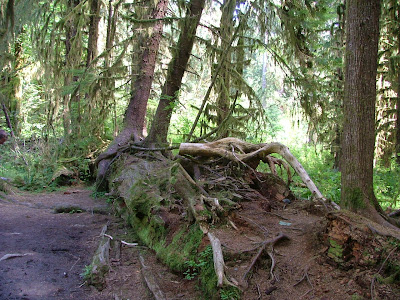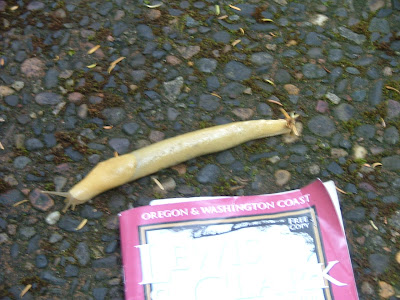This is the Washington seacoast. You see these vertical rocks, "Sea Stacks", all along. Proof that seeds are carried by the wind, or birds:
Proof that seeds are carried by the wind, or birds:
 Considering that all of these formations are due to soft stone getting eroded away while hard stone stays, it's not that surprizing that sometimes you get hole in the rock. Neat, though:
Considering that all of these formations are due to soft stone getting eroded away while hard stone stays, it's not that surprizing that sometimes you get hole in the rock. Neat, though:
 Lots of driftwood. They say it comes from rivers undermining the trees along their banks; the trees get carried down to the shore and end up here. They warn about trying to swim, or even beachcomb, while there are logs getting washed ashore; they can suddenly come at you on the back of a large wave, possibly with disastrous results. (Pretty cold for swimming, anyway).
Lots of driftwood. They say it comes from rivers undermining the trees along their banks; the trees get carried down to the shore and end up here. They warn about trying to swim, or even beachcomb, while there are logs getting washed ashore; they can suddenly come at you on the back of a large wave, possibly with disastrous results. (Pretty cold for swimming, anyway).
 No idea how this could happen; ereosion is strange stuff.
No idea how this could happen; ereosion is strange stuff.
 These layers extended a long way, lengthwise and crosswise....
These layers extended a long way, lengthwise and crosswise....
 Somebody decided to pile up stones -
Somebody decided to pile up stones -
 So we helped out -
So we helped out -
 A Zen-garden pile.
A Zen-garden pile.
 Sea Anemones,
Sea Anemones,

 Starfish - there weren't a lot of them. I suspect people of collecting them (which they are not supposed to do).
Starfish - there weren't a lot of them. I suspect people of collecting them (which they are not supposed to do).
 Sea lettuce
Sea lettuce
 Kelp. The big end is filled with gas, and floats on the surface so the attached 'leaves' can get sunlight. The bottom end, the 'holdfast', attaches tot a rock. This one was about 16 ft long, which seems to be about the limit for length.
Kelp. The big end is filled with gas, and floats on the surface so the attached 'leaves' can get sunlight. The bottom end, the 'holdfast', attaches tot a rock. This one was about 16 ft long, which seems to be about the limit for length.

 Proof that seeds are carried by the wind, or birds:
Proof that seeds are carried by the wind, or birds: Considering that all of these formations are due to soft stone getting eroded away while hard stone stays, it's not that surprizing that sometimes you get hole in the rock. Neat, though:
Considering that all of these formations are due to soft stone getting eroded away while hard stone stays, it's not that surprizing that sometimes you get hole in the rock. Neat, though: Lots of driftwood. They say it comes from rivers undermining the trees along their banks; the trees get carried down to the shore and end up here. They warn about trying to swim, or even beachcomb, while there are logs getting washed ashore; they can suddenly come at you on the back of a large wave, possibly with disastrous results. (Pretty cold for swimming, anyway).
Lots of driftwood. They say it comes from rivers undermining the trees along their banks; the trees get carried down to the shore and end up here. They warn about trying to swim, or even beachcomb, while there are logs getting washed ashore; they can suddenly come at you on the back of a large wave, possibly with disastrous results. (Pretty cold for swimming, anyway). No idea how this could happen; ereosion is strange stuff.
No idea how this could happen; ereosion is strange stuff. These layers extended a long way, lengthwise and crosswise....
These layers extended a long way, lengthwise and crosswise.... Somebody decided to pile up stones -
Somebody decided to pile up stones - So we helped out -
So we helped out - A Zen-garden pile.
A Zen-garden pile. Sea Anemones,
Sea Anemones,
 Starfish - there weren't a lot of them. I suspect people of collecting them (which they are not supposed to do).
Starfish - there weren't a lot of them. I suspect people of collecting them (which they are not supposed to do). Sea lettuce
Sea lettuce Kelp. The big end is filled with gas, and floats on the surface so the attached 'leaves' can get sunlight. The bottom end, the 'holdfast', attaches tot a rock. This one was about 16 ft long, which seems to be about the limit for length.
Kelp. The big end is filled with gas, and floats on the surface so the attached 'leaves' can get sunlight. The bottom end, the 'holdfast', attaches tot a rock. This one was about 16 ft long, which seems to be about the limit for length.

Beaches are beautiful, but sometimes they get a little boring...

Sea birds seem to be very social. They just there a lot of the time, instead of tending to business and catching fish.

 A Pelican
A Pelican
 The National Bird
The National Bird
 The Ocean can get pretty rough, too. I have unbounded admiration for the Coast Guard: Just when the weather is so bad that everyone else is advised to go back to port and sit by the fire, that's when the Coast Guard is supposed to go out to sea, to rescue somebody. This memorial is by the Coast Guard station near the Quileute River.
The Ocean can get pretty rough, too. I have unbounded admiration for the Coast Guard: Just when the weather is so bad that everyone else is advised to go back to port and sit by the fire, that's when the Coast Guard is supposed to go out to sea, to rescue somebody. This memorial is by the Coast Guard station near the Quileute River.
The mouth of the Quileute River, across from a village of the Quileute Indians. Many of the Indians on the Pacific coast fared better than others, in that when the white man took their lands they allowed them to retain fishing rights. The Indians here mostly farm or fish, and seemed to be reasonably well-off.

The Quileute alphabet. Very few Indian languages have anything at all in common with any of the others - why, nobody seems to know. When they had to communicate, they often resorted to Sign Language, which seems to have been pretty universal. Go figure.
 Trees out here can get really big:
Trees out here can get really big:
 It's hard to see, but most of the bark on this tree has been burned or torn away; As long as there is one strip of bark from the ground to the growing branches, the tree is still alive...
It's hard to see, but most of the bark on this tree has been burned or torn away; As long as there is one strip of bark from the ground to the growing branches, the tree is still alive...
 Sometimes it's hard being a 'Tree-hugger'...
Sometimes it's hard being a 'Tree-hugger'...

On our way inland to the rainforest, some summer-camp kids

Lumber companies have to plan for the long term: as soon as the land is logged, they start planning, and replanting. Oftentimes the diversity of trees is less, but at least there is forest.
 Lake Quinault, in the middle of one of the rainforests
Lake Quinault, in the middle of one of the rainforests
 And, the Northwest Temperate Rainforest. This is something you don't see that much - rainfall over 100 inches/year, and temperatures that don't get that cold in the winter. Lots of ferns,
And, the Northwest Temperate Rainforest. This is something you don't see that much - rainfall over 100 inches/year, and temperatures that don't get that cold in the winter. Lots of ferns,  Other ground plants...
Other ground plants... 


Sea birds seem to be very social. They just there a lot of the time, instead of tending to business and catching fish.

 A Pelican
A Pelican The National Bird
The National Bird The Ocean can get pretty rough, too. I have unbounded admiration for the Coast Guard: Just when the weather is so bad that everyone else is advised to go back to port and sit by the fire, that's when the Coast Guard is supposed to go out to sea, to rescue somebody. This memorial is by the Coast Guard station near the Quileute River.
The Ocean can get pretty rough, too. I have unbounded admiration for the Coast Guard: Just when the weather is so bad that everyone else is advised to go back to port and sit by the fire, that's when the Coast Guard is supposed to go out to sea, to rescue somebody. This memorial is by the Coast Guard station near the Quileute River.
The mouth of the Quileute River, across from a village of the Quileute Indians. Many of the Indians on the Pacific coast fared better than others, in that when the white man took their lands they allowed them to retain fishing rights. The Indians here mostly farm or fish, and seemed to be reasonably well-off.

The Quileute alphabet. Very few Indian languages have anything at all in common with any of the others - why, nobody seems to know. When they had to communicate, they often resorted to Sign Language, which seems to have been pretty universal. Go figure.
This alphabet has 8 characters corresponding roughly to our "k", and 4 "x"es.
 Trees out here can get really big:
Trees out here can get really big: It's hard to see, but most of the bark on this tree has been burned or torn away; As long as there is one strip of bark from the ground to the growing branches, the tree is still alive...
It's hard to see, but most of the bark on this tree has been burned or torn away; As long as there is one strip of bark from the ground to the growing branches, the tree is still alive... Sometimes it's hard being a 'Tree-hugger'...
Sometimes it's hard being a 'Tree-hugger'...
On our way inland to the rainforest, some summer-camp kids

Lumber companies have to plan for the long term: as soon as the land is logged, they start planning, and replanting. Oftentimes the diversity of trees is less, but at least there is forest.

Slash-piles: All the branches and roots they couldn't use in the sawmills. In other places they would burn these, since leaving them on the ground could fuel really big and dangerous forest fires. In places they waited until winter, when snow was on the ground, to do the burning. Here, they said they're not allowed to burn them at all because of all the air pollution it would cause in Seattle. Not sure exactly where that leaves us...
 Lake Quinault, in the middle of one of the rainforests
Lake Quinault, in the middle of one of the rainforests And, the Northwest Temperate Rainforest. This is something you don't see that much - rainfall over 100 inches/year, and temperatures that don't get that cold in the winter. Lots of ferns,
And, the Northwest Temperate Rainforest. This is something you don't see that much - rainfall over 100 inches/year, and temperatures that don't get that cold in the winter. Lots of ferns,  Other ground plants...
Other ground plants... 
And low bushes; often they grow not only on the ground but on fallen logs.
It's surprizing, to me anyway, how much ground cover there is. The trees let quite a lot of light in - unlike forests in the Northeast, where it may be quite dark with nothing much at all on the forest floor except dead leaves or needles. There's moss everywhere. This moss, unlike the Spanish Moss you see in the Southeast, is not a parasite and doesn't harm the host trees. It just uses them as a convenient place to hang out...
There's moss everywhere. This moss, unlike the Spanish Moss you see in the Southeast, is not a parasite and doesn't harm the host trees. It just uses them as a convenient place to hang out...
 It can grow on the trunks, too
It can grow on the trunks, too
 There's moss everywhere. This moss, unlike the Spanish Moss you see in the Southeast, is not a parasite and doesn't harm the host trees. It just uses them as a convenient place to hang out...
There's moss everywhere. This moss, unlike the Spanish Moss you see in the Southeast, is not a parasite and doesn't harm the host trees. It just uses them as a convenient place to hang out... It can grow on the trunks, too
It can grow on the trunks, too
And up on the treetops.
Another thing there is not so much of as in the East, is mushrooms and fungus. Don't know why that is, either.

Lots of fallen logs. The logs are rather slow to decay, for some reason.
There is a lot of stuff in a temperate rainforest. Tropical rainforests, aka jungles, don't actually have near as much. Some, in fact, don't get all that much rain; they just conserve it by allowing very little water out of the top canopy. They estimate there is three times as much biomass/acre here as in a tropical rainforest (down in the California Redwood forests, they claim 8 or 9 times as much).

Often the fallen logs become 'nurse logs'; seeds fall onto them and start growing right there. The log provides even more moisture than there is on the ground, and a leg up in getting sunlight as well.

Later on, when the tree has gotten big and the nurse log has finally decayed, you get this:

 This tree grew on a nurse stump, about 10 ft in the air:
This tree grew on a nurse stump, about 10 ft in the air:
 Which ended up giving it a really fancy root system:
Which ended up giving it a really fancy root system:
 At the other edge of this rainforest was an abandoned farmstead, with various tools and stuff:
At the other edge of this rainforest was an abandoned farmstead, with various tools and stuff:
 Banana Slugs: A thing out here. remarkable looking critters:
Banana Slugs: A thing out here. remarkable looking critters: 
They are not all yellow; it depends on what they've been eating.

Snail are as slow as, well, snails. In contrast, Banana Slugs can put on a pretty good turn of speed. I estimated this guy's top speed at about 9 ft per hour.

Later on, when the tree has gotten big and the nurse log has finally decayed, you get this:

 This tree grew on a nurse stump, about 10 ft in the air:
This tree grew on a nurse stump, about 10 ft in the air: Which ended up giving it a really fancy root system:
Which ended up giving it a really fancy root system: At the other edge of this rainforest was an abandoned farmstead, with various tools and stuff:
At the other edge of this rainforest was an abandoned farmstead, with various tools and stuff: Banana Slugs: A thing out here. remarkable looking critters:
Banana Slugs: A thing out here. remarkable looking critters: 
They are not all yellow; it depends on what they've been eating.

Snail are as slow as, well, snails. In contrast, Banana Slugs can put on a pretty good turn of speed. I estimated this guy's top speed at about 9 ft per hour.
The University of California at Santa Cruz adopted the Banana Slug as their mascot. (This was about the time of the Vietnam business, when students didn't trust anybody over thirty; the president of the school had wanted them to choose the Sealion, which seems a bit more appropriate for an athletic team.
In addition to UCSC's mascot, the Banana Slug is the Official State Mollusk of California.
And, no, banana slugs do not have eyes in their head; The eyes are actually at the end of the stalks. Water Striders. You can't really see them, here, but you can see the shadows cast by the dimples in the water where their feet are. They're so light they stand on top of the water, held by the surface tension.
Water Striders. You can't really see them, here, but you can see the shadows cast by the dimples in the water where their feet are. They're so light they stand on top of the water, held by the surface tension.
 On a Ranger-led walk, we're looking at fingerling salmon.
On a Ranger-led walk, we're looking at fingerling salmon.
 At one of the campsites, a herd of elk wandered through the campground at dusk and dawn.
At one of the campsites, a herd of elk wandered through the campground at dusk and dawn.
 Ouside the park, a large fallen tree stump
Ouside the park, a large fallen tree stump

Chainsaw art is really big here.
 It was Blackberry season, so we collected a lot. Sometimes we got a bit carried away...
It was Blackberry season, so we collected a lot. Sometimes we got a bit carried away...
 But it was worth it. The berries are huge, and very tasty. The locals don't seem to bother picking them very much.
But it was worth it. The berries are huge, and very tasty. The locals don't seem to bother picking them very much.

In the town of Raymond, Washington, they had a bunch of really neat 'sculptures' cut out of sheet iron:
 Water Striders. You can't really see them, here, but you can see the shadows cast by the dimples in the water where their feet are. They're so light they stand on top of the water, held by the surface tension.
Water Striders. You can't really see them, here, but you can see the shadows cast by the dimples in the water where their feet are. They're so light they stand on top of the water, held by the surface tension. On a Ranger-led walk, we're looking at fingerling salmon.
On a Ranger-led walk, we're looking at fingerling salmon. At one of the campsites, a herd of elk wandered through the campground at dusk and dawn.
At one of the campsites, a herd of elk wandered through the campground at dusk and dawn. Ouside the park, a large fallen tree stump
Ouside the park, a large fallen tree stump
Chainsaw art is really big here.
 It was Blackberry season, so we collected a lot. Sometimes we got a bit carried away...
It was Blackberry season, so we collected a lot. Sometimes we got a bit carried away... But it was worth it. The berries are huge, and very tasty. The locals don't seem to bother picking them very much.
But it was worth it. The berries are huge, and very tasty. The locals don't seem to bother picking them very much.
In the town of Raymond, Washington, they had a bunch of really neat 'sculptures' cut out of sheet iron:



